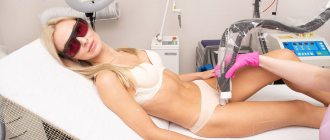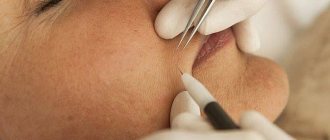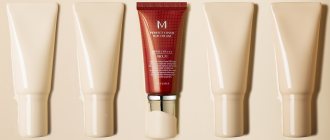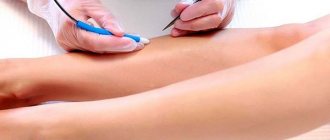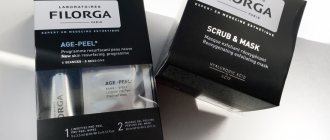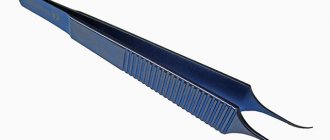GENERAL TERMS
Conditions that must be met in order for the electrolysis procedure to take place and be completely effective:
- Your hair should be at least 3-4 mm. in length so that they can be grasped with tweezers without difficulty;
- Your hair should be clearly visible so that the master can easily and quickly determine the direction of its growth and ensure clear insertion of the needle along the direction of hair growth (for this you need to clearly see the base of the hair). Also, coloring will completely remove even the thinnest colorless hair. In order to color your hair correctly, read the coloring instructions.
- Depending on the degree of your sensitivity (pain threshold), before the electrolysis procedure it is necessary to numb the treated area. Only a certain percentage of people (which, according to statistics, is very small) can do electrolysis live (without resorting to anesthesia, i.e. without prior preparation). Everyone else needs pain relief. There are two ways:
Pain relief during epilation of the bikini area
The procedure for bikini hair removal using the LightSheer DUET diode laser is painless, so anesthesia is usually not used. However, with each session of the course the doctor increases the laser power. At the same time, discomfort during intimate hair removal may increase. You should immediately report any unpleasant sensations to your cosmetologist, putting aside any shyness. The doctor must clearly know what sensations the patient is experiencing, because the degree of sensitivity is different for everyone. And what anesthesia to use to make the procedure as comfortable as possible.
Application anesthesia (occlusive dressing/occlusion).
Used for pain relief:or large areas of the body such as:- shins;
- hips;
- shoulders and forearms;
or where sensitivity is not clearly expressed:
- usually this is the chest area;
or before injection anesthesia - to reduce pain during injection (if the pain threshold is very low):
- armpits;
- classic bikini;
- deep bikini;
- intergluteal zone;
- anus.
The main disadvantages of topical anesthesia are as follows:
- in a short duration of action after removing the film;
- often the depth of penetration of the anesthetic (spray/gel/cream) is not enough for complete anesthesia - slight sensitivity remains;
- sometimes unevenly anesthetized/weakly anesthetized areas remain due to the uneven distribution of the anesthetic under the film;
Leave a request
Do I need painkillers for laser hair removal in the bikini area? We find out from an expert at the Epilike clinic.
“Hello, I’ve been planning to take a course of intimate laser hair removal for a long time. Before that, I only did bikinis with the help of sugaring. It was very painful for me, so I’m looking for a more gentle and effective way to remove hair. Tell me, what kind of anesthesia exists for laser hair removal?”
Vera, Khimki.
Elena Makarova, a cosmetologist and dermatovenerologist at the Epilike clinic, answers the question:
“Vera, hello! In theory, the intimate laser hair removal procedure using the LightSheer DUET diode device is considered painless. But my many years of practice show that patients with a low sensitivity threshold need additional pain relief. Therefore, at the Epilike clinic, during the procedure we use cream anesthesia, refrigerants or cryoblowing.”
Injection anesthesia (injections).
Used for pain relief: small areas of the body where sensitivity is especially high:- pubis;
- armpits;
- deep bikini;
- intergluteal zone;
- anus;
- phalanges of toes/hands;
- face: mustache, nasolabial fold, eyebrows;
Injection anesthesia is performed on site by a specialist in the form of subcutaneous injections. Completely relieves pain within 1-2 minutes (you can work right away). Total pain relief (sensitivity disappears completely).
Rules for choosing a cream
Anesthetic cream is one of the most effective and popular remedies. They are easy to use and start working as quickly as possible.
But there are also secrets here. When choosing a cream, you need to answer two important questions:
1. Could I be allergic to this cream?
Before applying the cream, it is worth checking the product so that it does not cause allergies. To do this, apply a little ointment to the elbow bend and wait 30-40 minutes. If after this time no allergic reaction is noticed on the skin, then feel free to use this remedy for pain relief.
2. Are there any contraindications?
There is a huge selection on the beauty market: Light dep, Deep Numb, Doctor Numb, Prilocaine, etc. Each of these creams is effective on a specific area of the body and has clear instructions and contraindications that you should read before purchasing.
We examined specific drugs in more detail in the section: “Popular drugs”.
How to properly apply topical anesthesia:
Application anesthesia is done in advance - 1.5-2 hours (for rough tissues: shins/arms/buttocks/thighs), 1-1 hour 10 minutes (for delicate tissues: deep bikini, intergluteal area, face), 50-55 minutes. (for mucous membranes) before the start of the procedure. For this, anesthetics based on lidocaine/prilocaine are used in the form of sprays (Lidocaine spray) or creams/gels ( Doctor Numb , Emla, F&E Tattoist , Beracaine gel , J-caine , Light Dep and others...). If you use a spray, be sure to buy lidocaine spray “Egis” 10% (made in Hungary). Like this:
Is it painful to do electrolysis?
Having learned about how the electrolysis method works and the variations in the use of current to remove unwanted hair, many of you have wondered whether it hurts, because a current discharge will be passed through your body. This is exactly what we will talk about next.
Painful sensations depend not only on the method itself, but also on a large number of factors:
- pain threshold;
- “advancement” of equipment;
- the level of the specialist who performs the procedure;
- hair removal method used;
- skin thickness;
- number of nerve endings.
It turns out that one person can be incredibly painful, and another will feel the same sensations, only they will compare them to mosquito bites.
The level of pain is also affected by the type of needle used. An insulated needle causes less pain because it concentrates the electrical discharge at one point. A non-insulated needle is more painful, since it “shocks” not only the follicle itself, but also the surrounding tissues.
In any case, electrolysis is a very painful method of hair removal . This is why electrolysis is not performed without anesthesia (only if you refuse it yourself), so you should not imagine this procedure as medieval torture.
Just 25 years ago, everyone bought portable devices and, with tears in their eyes, manually removed every hair without painkillers. Now there are a huge number of drugs that will completely numb the pain and allow a specialist to quickly remove unwanted vegetation.
Other sprays don't work.
The order is as follows:
Go to the bathroom/restroom. The skin should be as warm as possible (so that the pores are open and the anesthetic can penetrate faster and to a greater depth). If your skin is cold, warm it under warm water. It is advisable to rub the treated area with a hard washcloth/scrub (to remove dead cells - again for better absorption of the anesthetic into the skin). Next, apply generously either:
- lidocaine - spray (be sure to close your airways with a mask/insert cotton wool pads into your nose so as not to breathe in when applying) right before the flow. Don’t skimp – if you apply little, the effect will be weak or not at all;
- lidocaine cream/gel - a uniform layer of approximately 1 mm over the entire surface where the procedure is supposed to be carried out, like this:
Also, do not save too much cream/gel; if the layer is insufficient, the sensitivity will remain high;
Next, wrap tightly with cling film (the first layer is simply imprinted/glued onto the anesthetic). Try as much as possible to avoid access of air under the film - it is enough to wrap 2 layers so that the film lays with a margin beyond the area covered with anesthetic (reserve for slipping, sliding of the film when walking/moving). You can secure the edges of the film with masking tape/adhesive tape to prevent it from slipping. There are also special anesthetic patches on sale. When you arrive for the procedure in this form, the master himself gradually turns you around.
Electrolysis: the view of a practicing cosmetologist
Electrolysis is the gold standard of permanent hair removal. Light hair removal methods have long been established on the market, new types of lasers appear regularly, one is better than the other, but the good old electrolysis, essentially unchanged, does not lose its relevance, and here’s why.
The point of hair removal, which can permanently remove hair, is to destroy the hair follicle. After all, for example, when shaving or plucking (say, with wax), the hair itself is simply removed, but its root, the follicle, is either not affected by this process or is even stimulated.
The principle of electrolysis is clear to everyone - a needle is inserted into each hair follicle, the master presses the pedal and a current is applied to the needle, which destroys the follicle. If a hair is “killed,” it can be easily removed with tweezers and will not grow back (but the hair will still be restored due to other, unprocessed hair that is “dormant” at the time of the procedure).
Electric epilators use two main modes - flash and blend . The flash mode is based on thermolysis - heating the follicle. Alternating current quickly “fries” the follicle with a short and powerful high-frequency pulse, causing its thermal burn - coagulation. The method requires the specialist to accurately hit the follicle, since the entire process develops only at the tip of the electrode needle.
In the “blend” mode, electrolysis works - the influence of direct current, it is also called galvanic. In this case, a chemical reaction occurs at the tip of the needle, as a result of which an alkali is formed, which, spreading along the hair canal, causes a chemical burn of the follicle, so the accuracy of hitting the follicle is not so important. When working in this mode, a passive electrode is required and the process takes many times longer; you need to spend several seconds on each hair, i.e. the blend is low-performing and in monetary terms will be much more expensive than a flash.
But even in flash mode, electrolysis will currently cost the client more than all other hair removal methods. After all, in fact, it is possible to process an area of approximately 10 by 10 cm in an hour. But with its help you can get rid of any hair - light, coarse, vellus, and gray, and on any skin phototype.
Why doesn’t every salon in the city offer such a wonderful classical technique? Firstly, because it, like any hardware cosmetology procedure, requires a medical license. Secondly, according to the law, all manipulations that violate the integrity of the skin are performed only by a cosmetologist with the appropriate diplomas and certificates. Thirdly, the method itself is labor-intensive for a specialist, is associated with prolonged eye strain and is boring for some. But there are also those who find such monotonous work as meditation and a long working day even diversifying.
No special preparation is required before electrolysis. You can scrub the areas where the manipulation will take place, and it is also advisable to take a bath in advance. The main thing is the length of the hairs, it should be at least 2 mm so that it can be easily caught with tweezers.
All hair removal methods are painful, but electrolysis is especially painful. And pain relief with cream will not help, because... the cream anesthetizes only the superficial layers of the skin, 1-2 mm, and the follicle is located deeper - in the hair canal, up to eight millimeters in depth. Only infiltration anesthesia with dental anesthetics will be effective; most often this method has to be used on the upper lip.
Possible complications
Most often, irritation after electrolysis is not a complication; it is a normal skin reaction to microburns. Immediately or a few minutes after the procedure, swelling and perifollicular erythema occurs, lasts a couple of hours or a couple of days and can be easily removed with any cold gel, it is best to buy fenistil or curiosin at the pharmacy. Just don’t cover up this irritation with creams, because... the oil included in their formulation will create an occlusive effect and increase the inflammatory response.
If the hairs were coarse and a powerful impulse was used, crusts may form; under no circumstances should they be peeled off. They will pass in a few days without leaving a trace.
Scars are a medical error in its purest form. The fact is that the specialist sees the appearance of a scar immediately during the procedure with the naked eye. It looks like a white halo of necrosis around the hair. Therefore, measures in such cases are taken immediately: the current strength is reduced and means are used to promote epithelization and wound healing.
Modern devices do not provide hyperpigmentation even on the 4th phototype. It can only be obtained by grossly violating the rules of skin care after the procedure, for example, tearing off the crust and going to sunbathe.
Hematomas and hemorrhages occur because each hair follicle has its own vessel and it is very easy to hurt it, especially in areas with thin skin. Treatment is ointment with heparin or bodyaga.
Ingrown hairs are a typical complication of electrolysis, as well as waxing, and in general any where the hair is extracted. Treated with repeated epilation.
If a passive electrode is not used, then the current does not pass through the patient’s body and there will be fewer contraindications:
- oncological diseases;
- blood diseases;
- tendency to form hyperplastic and keloid scars;
- presence of a pacemaker;
- pregnancy;
- breastfeeding period.
Before and after the procedure, it is not advisable to visit a bathhouse, sauna, or solarium. Taking hormonal medications, as well as waxing or sugaring may reduce the effectiveness of the procedure.
How long does an electrolysis session last and how many procedures are needed?
Electrolysis must be carried out by a qualified specialist. Its essence is to direct charged electrical particles to the area of the hair follicle. Due to the fact that the temperature of these particles is very high, the hair root is destroyed, this leads to the complete destruction of the hair forever.
Bikini electrolysis training. Video
There is a small nuance: such an effect is qualitatively possible only on those hairs that are in the stage of active development and growth, in the so-called anagen phase. There is old hair on the skin that has already grown and there is hair that is still under the skin; electrical particles do not affect them, so electrolysis must be done several times to completely cleanse unwanted hair.
As a result, a special course is required, which can last up to several weeks and include 4-8 visits to a specialist. Each procedure becomes much shorter than the previous one, because there is less hair in unwanted places. After the full course has ended, procedures begin to individually remove those hairs that still remain.
The number of visits and duration of the course depends on many factors, for example, the thickness of the hair and the size of the area where it spreads. If you contact a specialist, after an examination he will be able to tell you approximately how many procedures need to be applied. But no specialist will be able to see exactly how much hair remains under the skin.
If the client used shaving as a means of hair removal before visiting a specialist, then this is the best option. And if you have used laser hair removal or another method, then dormant hair may appear only after several electrolysis procedures.
In our body, even before birth, information is stored at the gene level regarding which we have a certain number of hair follicles.
If you remove hair from the roots of these follicles and destroy them, new hair will never grow again.
Cost of the procedure
| Specialist consultation | for free |
| Electrolysis, center manager, 1 minute | 34-00 r. |
| Electrolysis, specialist, 1 minute | 30-00 r. |
| Needle | 120-00 rub. |
| Invasive anesthesia (ultracaine) | 500-00 rub. |
| Application anesthesia (cream) | from 300-00 rub. |
| * Minimum procedure time - 30 minutes |
How to care for your skin after electrolysis?
Skin restoration after all manipulations takes about a week.
Following simple rules will help you quickly recover after electrolysis:
- the treated area of skin should not come into contact with water for the first 24 hours.
- For the first three days, refrain from taking a hot bath, as well as from using any creams and perfumes (if hair removal was done on the face, then refrain from using decorative cosmetics).
- For 4-5 days, you should regularly treat the skin with an antiseptic prescribed by your doctor to avoid infection.
- It is forbidden to sunbathe in the first week to prevent age spots from appearing.
- refrain from physical activity. Excessive sweating will cause you to take longer to recover.
- Do not under any circumstances peel off the crusts that have arisen after removal. Otherwise, scars may appear in their place.
- Do not touch the skin with dirty hands to avoid infection in the wounds.
- do not visit the pool and sauna.
- Take care that clothing and underwear do not rub the treated body parts. Wear loose-fitting clothes.
Popular means
The beauty industry offers a lot of painkillers that come to the aid of women during hair removal and depilation. There are several drugs that have been tested by time and thousands of women. We will talk about them below.
Doctor Namb cream is used to reduce pain during laser and wax hair removal. Before applying the cream, the area of skin where hair removal will be carried out should be washed with soap and treated with alcohol. The analgesic effect lasts from 3 to 5 hours.
Light Dep is well suited for epilation of bikini areas, face and armpits. The cream does not cause an allergic reaction and maintains the analgesic effect for up to 4 hours.
Depilflax gel is used for wax hair removal. It has a cooling, analgesic and disinfectant effect. But this remedy is quite weak, so it is not used for painful depilation methods.
Anestop gel is a strong anesthetic that is used for various types of hair removal. It begins to act in 25 minutes and lasts for 3 hours. This gel is perfect for bikini hair removal.
Anesthetic colloidal solution Golden Rose anesthetizes the skin for 40 - 60 minutes and almost does not cause allergies.
Prilocaine is designed specifically for pain relief on the skin. The spray can be used for various types of hair removal and depilation. The effect begins after 3 – 3.5 hours under an occlusive dressing. Although this drug has a number of contraindications and side effects that are worth familiarizing yourself with.
VEET spray is two in one: an anesthetic and a depilatory agent. It is used in the armpits, legs and bikini areas, and when used on the face, chest and groin can cause severe irritation and an allergic reaction.
How to apply cooling cream?
Cooling cream helps relieve pain during hair removal. It slightly freezes the top layer of skin and thereby facilitates the procedure. But this remedy will not be able to completely numb the pain, since freezing does not penetrate deep into the skin.
If you are convinced that the cream has not caused any harm to your skin, proceed directly to use:
- First, steam your skin to make epilation easier.
- Dry the area to be treated and then apply the product. The cream is applied in a thin layer (1 – 2 grams per 10 cm2). But anesthesia for bikini hair removal requires a larger amount of cream: 5 - 10 g.
- It is also advisable to apply an occlusive dressing. It is very simple to do: the area with the applied cream needs to be covered with a thin plastic film and secured around the edges with an adhesive plaster.
- After the time specified in the instructions has expired (usually from 25 minutes to 2 hours), remove the cream with a napkin.
Now you can start the hair removal itself.
You also need to remember that the cream should not be applied to damaged skin, as an allergic reaction may occur.
What to look for when choosing a location
Nowadays, numerous private masters offer electrolysis services at home, in offices and in offices, which is certainly illegal. Electrolysis is a medical procedure performed by a doctor or cosmetologist with a medical education within the walls of an institution with a medical license, where there is everything necessary to provide emergency assistance in the event of a force majeure situation, for example, an allergic reaction to pain medications, where the qualifications of the specialist performing the procedure are confirmed competent government authorities.
There are at least three aspects that you should rely on when choosing a location for electrolysis:
- availability of a medical license from the clinic or center.
- availability of medical education from the specialist performing the procedure. The quality of work directly depends on the qualifications of the specialist. The electrolysis procedure is quite complex and requires precision and high professionalism from the one who performs it. Therefore, you need to carefully choose the specialist who will do it for you, primarily based on his experience.
- availability of modern, efficient equipment , which, as a rule, private craftsmen cannot afford.
